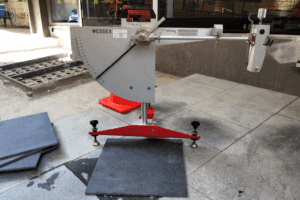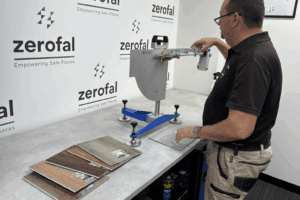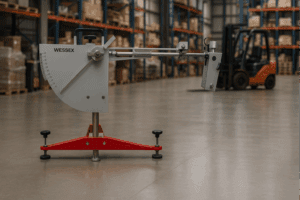AS 4586-2013 Explained: Understanding P and D Ratings
What Do P and D Ratings Really Mean?
AS 4586-2013 is the standard for testing new pedestrian surfaces before installation. P-ratings (P0–P5) measure wet slip resistance; D-ratings (D0/D1) apply to always-dry areas. This guide explains how they’re tested, when to use each rating, and how to stay compliant.
Whether you’re a tile manufacturer, architect, or compliance officer, you’ve probably seen terms like “P4” or “D1” on a slip test report. But what do those ratings really mean—and how are they determined?
This is your guide to AS 4586-2013, the Australian Standard for measuring the slip resistance of new pedestrian surfaces. The “P” and “D” classifications are more than just labels—they’re what stand between a compliant product and a safety risk.
What Is AS 4586-2013?
AS 4586-2013 outlines the methods for testing new surface materials before installation. It covers both wet and dry conditions using lab-based equipment under controlled settings.
The two most common tests used are:
- Wet Pendulum Test → Produces a P-rating (P0–P5)
- Dry Floor Friction Test → Produces a D-rating (D0 or D1)
Other methods (Oil Wet Ramp and Wet Barefoot Ramp) exist, but most flooring suppliers and builders only need the two above.
Understanding P-Ratings (Wet Pendulum Test)
The P-rating tells you how a surface performs when wet—the most common condition for slips.
| P-Rating | Slip Resistance (Wet Use) | Typical Applications |
|---|---|---|
| P5 | Highest resistance | Kitchens, ramps, commercial zones |
| P4 | High resistance | Entries, bathrooms, produce aisles |
| P3 | Moderate resistance | Public toilets, foyers |
| P2 | Low resistance | Dry-use internal areas only |
| P1 / P0 | Minimal resistance | Not suitable for wet areas |
A P3 rating might be fine for a dry foyer, but completely insufficient for a produce aisle or commercial kitchen.
Understanding D-Ratings (Dry Floor Friction Test)
The D-rating applies only to areas that are always dry. It measures slip resistance using a floor friction tester (the Tortus III) that simulates walking across the surface.
| D-Rating | Classification | |
|---|---|---|
| D1 | Pass – dry floor is compliant | |
| D0 | Fail – dry floor is unsafe under standard conditions | |
Dry floor friction testing is typically used for smooth indoor floors that are not intended to get wet-like tiles, sealed vinyl, or timber-look laminates.
Common Compliance Pitfalls
- Testing raw tiles only: If the surface is sealed or coated before sale, you must test the treated version.
- Mismatched product claims: If you label a tile P4, but it’s coated to a P2 in practice, you’re liable for misrepresentation.
- Wrong test for the use-case: D-ratings should never be used to justify safety in areas that may get wet.
- Assuming manufacturer data is enough: Compliance requires test reports that reflect your exact product, finish, production batch and format.
What To Do
- Test every finished surface under AS 4586-2013 before handover or sale
- Include the P or D classification in documentation for certifiers, designers, and contractors
- Re-test if coatings or finishes change
- Use a NATA- certified lab like Zerofal for accredited, accurate results
At Zerofal, we test using Wet Pendulums and Tortus III Dry Friction systems—both calibrated to national standards. Your results are traceable, certifiable, and audit-ready.
Certify Your Surface—Correctly, and Compliantly
Zerofal provides certified slip testing to AS 4586-2013 using calibrated wet pendulum and dry friction methods. Whether you’re testing sealed tiles, vinyl planks, laminates or coatings, we’ll give you a clear, audit-ready result.
Explore more

Colour, Grit and Surface Finish: How Subtle Differences Change Slip Ratings (AS 4586:2013)
Colour, grit and finish change slip resistance. Learn why P-ratings vary across tile ranges and coatings

Why One Slip Test Isn’t Enough for Product Lines (AS 4586:2013)
Slip resistance varies across colours and finishes. Learn why one AS 4586 test cannot certify an entire product line.

Industrial Slip Resistance: Dust, Boots & Coating Drift (AS 4663:2013)
: Industrial floors change fast. Learn how dust, coatings and machinery reduce slip resistance and why AS 4663 onsite testing is essential.
Stay Ahead of Safety Standards
Join the Zerofal newsletter for actionable insights on slip testing, compliance updates, and smart prevention strategies. No spam – just practical safety advice.
